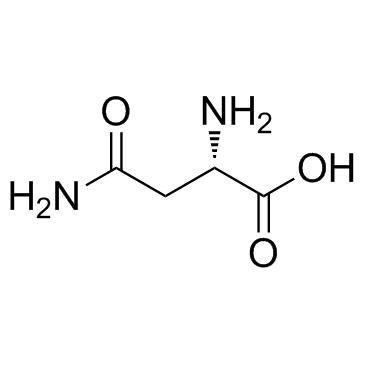L-asparagine

L-asparagine structure
|
Common Name | L-asparagine | ||
|---|---|---|---|---|
| CAS Number | 70-47-3 | Molecular Weight | 132.118 | |
| Density | 1.4±0.1 g/cm3 | Boiling Point | 438.0±40.0 °C at 760 mmHg | |
| Molecular Formula | C4H8N2O3 | Melting Point | 235 °C (dec.)(lit.) | |
| MSDS | Chinese USA | Flash Point | 218.7±27.3 °C | |
|
Characterisation of a putative AraC transcriptional regulator from Mycobacterium smegmatis.
Tuberculosis (Edinb.) 94(6) , 664-71, (2015) MSMEG_0307 is annotated as a transcriptional regulator belonging to the AraC protein family and is located adjacent to the arylamine N-acetyltransferase (nat) gene in Mycobacterium smegmatis, in a gene cluster, conserved in most environmental mycobacterial sp... |
|
|
Development of High-purity Certified Reference Materials for 17 Proteinogenic Amino Acids by Traceable Titration Methods.
Anal. Sci. 31 , 805-14, (2015) To ensure the reliability of amino acid analyses, the National Metrology Institute of Japan of the National Institute of Advanced Industrial Science and Technology (NMIJ/AIST) has developed high-purity certified reference materials (CRMs) for 17 proteinogenic... |
|
|
Use of Commercial Dry Yeast Products Rich in Mannoproteins for White and Rosé Sparkling Wine Elaboration.
J. Agric. Food Chem. 63 , 5670-81, (2015) In sparkling wines, mannoproteins released during yeast autolysis largely affect their final quality. This process is very slow and may take several months. The aim of this work was to study the effect of several commercial dry yeast autolysates on the chemic... |
|
|
The human serum metabolome.
PLoS ONE 6(2) , e16957, (2011) Continuing improvements in analytical technology along with an increased interest in performing comprehensive, quantitative metabolic profiling, is leading to increased interest pressures within the metabolomics community to develop centralized metabolite ref... |
|
|
Metabolomic profiles delineate potential role for sarcosine in prostate cancer progression.
Nature 457(7231) , 910-4, (2009) Multiple, complex molecular events characterize cancer development and progression. Deciphering the molecular networks that distinguish organ-confined disease from metastatic disease may lead to the identification of critical biomarkers for cancer invasion an... |
|
|
Automated screening of urine samples for carbohydrates, organic and amino acids after treatment with urease.
J. Chromatogr. A. 562(1-2) , 125-38, (1991) Eighty-five clinical urine samples and nineteen urine samples previously found by other laboratories to suggest genetic metabolic defects were prepared for trimethylsilylation by treatment with urease, followed by azeotropic dehydration. The "Target Analyte S... |
|
|
The human cerebrospinal fluid metabolome
J. Chromatogr. B. Analyt. Technol. Biomed. Life Sci. 871(2) , 164-73, (2008) With continuing improvements in analytical technology and an increased interest in comprehensive metabolic profiling of biofluids and tissues, there is a growing need to develop comprehensive reference resources for certain clinically important biofluids, suc... |
|
|
Urinary and plasma organic acids and amino acids in chronic fatigue syndrome.
Clin. Chim. Acta 361(1-2) , 150-8, (2005) Previous work by others have suggested the occurrence of one or more chemical or metabolic 'markers' for ME/CFS including specific amino acids and organic acids and a number of unidentified compounds (CFSUM1, CFSUM2). We have shown elsewhere that CFSUM1 is pa... |
|
|
Detection of autosomal dominant polycystic kidney disease by NMR spectroscopic fingerprinting of urine.
Kidney Int. 79(11) , 1244-53, (2011) Autosomal dominant polycystic kidney disease (ADPKD) is a frequent cause of kidney failure; however, urinary biomarkers for the disease are lacking. In a step towards identifying such markers, we used multidimensional-multinuclear nuclear magnetic resonance (... |
|
|
A Simple and Green Route for Room-Temperature Synthesis of Gold Nanoparticles and Selective Colorimetric Detection of Cysteine.
J. Food Sci. 80 , N2071-8, (2015) Gold nanoparticles (AuNPs) were synthesized at room temperature following a simple, rapid, and green route using fresh-squeezed apple juice as a reducing reagent. The optimal AuNPs, based on the particle color, stability, and color change suitable for colorim... |